Association Between Insulin-like Growth Factor-1 rs35767 Polymorphism and Type 2 Diabetes Mellitus Susceptibility: A Meta-Analysis
- PMID: 34880907
- PMCID: PMC8646032
- DOI: 10.3389/fgene.2021.774489
Association Between Insulin-like Growth Factor-1 rs35767 Polymorphism and Type 2 Diabetes Mellitus Susceptibility: A Meta-Analysis
Abstract
Background: Insulin-like growth factor-1 (IGF-1) has been demonstrated to increase fatty acid β oxidation during fasting, and play an important role in regulating lipid metabolism and type 2 diabetes mellitus (T2DM). The rs35767 (T > C) polymorphism, a functional SNP was found in IGF-1 promoter, which may directly affect IGF-1 expression. However, the inconsistent findings showed on the IGF-1 rs35767 polymorphism and T2DM risk. Methods: We performed a comprehensive meta-analysis to estimate the association between the IGF-1 rs35767 and T2DM risk among four genetic models (the allele, additive, recessive and dominant models). Results: A total 49,587 T2DM cases and 97,906 NDM controls were included in the allele model, a total 2256 T2DM cases and 2228 NDM controls were included in the other three genetic models (the additive; recessive and dominant models). In overall analysis, the IGF-1 rs35767 was shown to be significantly associated with increased T2DM risk for the allele model (T vs. C: OR = 1.251, 95% CI: 1.082-1.447, p = 0.002), additive model (homozygote comparisons: TT vs. CC: OR = 2.433, 95% CI: 1.095-5.405, p = 0.029; heterozygote comparisons: TC vs. CC: OR = 1.623, 95% CI: 1.055-2.495, p = 0.027) and dominant model (TT + CT vs. CC: OR = 1.934, 95% CI: 1.148-3.257, p = 0.013) with random effects model. After omitting Gouda's study could reduce the heterogeneity, especially in the recessive model (TT vs. CC + CT: I2 = 38.7%, p = 0.163), the fixed effects model for recessive effect of the T allele (TT vs. CC + CT) produce results that were of borderline statistical significance (OR = 1.206, 95% CI: 1.004-1.448, p = 0.045). And increasing the risk of T2DM in Uyghur population of subgroup for the allele model. Conclusion: The initial analyses that included all studies showed statistically significant associations between the rs35767 SNP and type 2 diabetes, but after removing the Gouda et al. study produced results that were mostly not statistically significant. Therefore, there is not enough evidence from the results of the meta-analysis to indicate that the rs35767 SNP has a statistically significant association with type 2 diabetes.
Keywords: insulin-like growth factor-1; meta-analysis; rs35767; susceptibility; type 2 diabete mellitus.
Copyright © 2021 Zeng, Zou, Zeng, Chen, Wei and Guo.
Conflict of interest statement
The authors declare that the research was conducted in the absence of any commercial or financial relationships that could be construed as a potential conflict of interest.
Figures





Similar articles
-
The relationship between polymorphism of insulin-like growth factor I gene and susceptibility to type 2 diabetes in Uygur population, Xinjiang, China.Genes Genomics. 2022 Apr;44(4):499-508. doi: 10.1007/s13258-021-01209-6. Epub 2022 Jan 30. Genes Genomics. 2022. PMID: 35094288 Free PMC article.
-
Association between insulin-like growth factor 1 gene rs35767 polymorphisms and cancer risk: A meta-analysis.Medicine (Baltimore). 2019 Nov;98(46):e18017. doi: 10.1097/MD.0000000000018017. Medicine (Baltimore). 2019. PMID: 31725675 Free PMC article.
-
Apolipoprotein A5 gene promoter region-1131T/C polymorphism is associated with risk of ischemic stroke and elevated triglyceride levels: a meta-analysis.Cerebrovasc Dis. 2012;33(6):558-65. doi: 10.1159/000338781. Epub 2012 Jun 8. Cerebrovasc Dis. 2012. PMID: 22688093
-
Association of the insulin-like growth factor-1 single nucleotide polymorphisms rs35767, rs2288377, and rs5742612 with osteoporosis risk: A meta-analysis.Medicine (Baltimore). 2017 Dec;96(51):e9231. doi: 10.1097/MD.0000000000009231. Medicine (Baltimore). 2017. PMID: 29390475 Free PMC article. Review.
-
Associations between rs3480 and rs16835198 gene polymorphisms of FNDC5 with type 2 diabetes mellitus susceptibility: a meta-analysis.Front Endocrinol (Lausanne). 2022 Aug 8;13:946982. doi: 10.3389/fendo.2022.946982. eCollection 2022. Front Endocrinol (Lausanne). 2022. PMID: 36004352 Free PMC article.
Cited by
-
IGF1 Genetic Polymorphism and the Association between Vitamin D Status and BMI Percentiles in Children.Children (Basel). 2023 Sep 27;10(10):1610. doi: 10.3390/children10101610. Children (Basel). 2023. PMID: 37892272 Free PMC article.
-
Association of vitamin D receptor gene rs739837 polymorphism with type 2 diabetes and gestational diabetes mellitus susceptibility: a systematic review and meta-analysis.Eur J Med Res. 2022 May 7;27(1):65. doi: 10.1186/s40001-022-00688-x. Eur J Med Res. 2022. PMID: 35526059 Free PMC article.
-
Use of blood glucose level for predicting the degree of coronary artery disease and cardiovascular adverse events in diabetic patients with acute coronary syndrome.Am J Transl Res. 2025 Apr 15;17(4):3179-3188. doi: 10.62347/AQXW7292. eCollection 2025. Am J Transl Res. 2025. PMID: 40385062 Free PMC article.
-
Association of the GHRd3 polymorphism with adult height and type 2 diabetes in a Saudi Arabian population from Jazan Province: A case-control study.Pak J Med Sci. 2024 Jan-Feb;40(3Part-II):308-312. doi: 10.12669/pjms.40.3.7686. Pak J Med Sci. 2024. PMID: 38356830 Free PMC article.
-
Trends in insulin resistance: insights into mechanisms and therapeutic strategy.Signal Transduct Target Ther. 2022 Jul 6;7(1):216. doi: 10.1038/s41392-022-01073-0. Signal Transduct Target Ther. 2022. PMID: 35794109 Free PMC article. Review.
References
-
- Chistiakov D. A., Nikitin A. G., Smetanina S. A., Bel'chikova L. N., Suplotova L. A., Shestakova M. V., et al. (2012). The Rs11705701 G>A Polymorphism of IGF2BP2 Is Associated with IGF2BP2 mRNA and Protein Levels in the Visceral Adipose Tissue - A Link to Type 2 Diabetes Susceptibility. Rev. Diabet Stud. 9, 112–122. 10.1900/RDS.2012.9.112 - DOI - PMC - PubMed
Publication types
LinkOut - more resources
Full Text Sources
Miscellaneous

